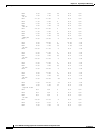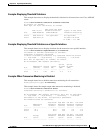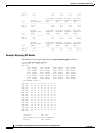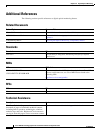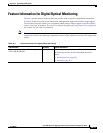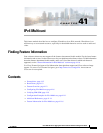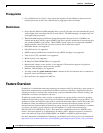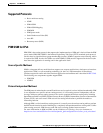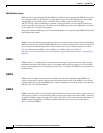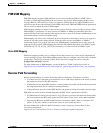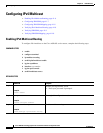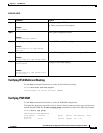
41-2
Cisco ASR 901 Series Aggregation Services Router Software Configuration Guide
OL-23826-09
Chapter 41 IPv4 Multicast
Feature Overview
Prerequisites
• Cisco IOS Release 15.4(1)S or a later release that supports the IPv4 Multicast feature must be
installed previously on the Cisco ASR 901 Series Aggregation Services Router.
Restrictions
• Source Specific Multicast (SSM) mapping takes a group G join from a host and identifies this group
with an application associated with one or more sources. The SSM mapping can support only one
such application per group G.
• When both SSM mapping and Internet Group Management Protocol Version 3 (IGMPv3) are
enabled and the hosts already support IGMPv3 (but source specific information is not present), they
start sending IGMPv3 group reports. These IGMPv3 group reports are not supported with SSM
mapping and the router does not correctly associate sources with these reports.
• PIM Dense Mode is not supported.
• Only PIM version 2 is supported.
• IGMP snooping and Multicast Listener Discovery (MLD) snooping is not supported.
• Time-To-Live (TTL) threshold is not supported.
• Mroute ageing is not supported.
• Bi-Directional PIM (BIDIR-PIM) is not supported.
• Mroute based counter or rate statistics is not supported. The hardware supports only physical
interface based multicast counter and rate statistics.
• Multicast VPN (MVPN) is not supported.
• You must enable the asr901-multicast source command on the SVI interface that is connected to
the traffic source for PIM sparse mode.
• IPv4 multicast is not supported in VRF lite.
Feature Overview
IP multicast is a bandwidth-conserving technology that reduces traffic by delivering a single stream of
information simultaneously to potentially thousands of businesses and homes. Applications that take
advantage of multicast include video conferencing, corporate communications, distance learning, and
distribution of software, stock quotes, and news.
IP multicast routing enables a host (source) to send packets to a group of hosts (receivers) anywhere
within the IP network by using a special form of IP address called the IP multicast group address. The
sending host inserts the multicast group address into the IP destination address field of the packets and
IP multicast routers and multilayer switches forward the incoming IP multicast packets out of all
interfaces that lead to the members of the multicast group. Any host, regardless of whether it is a member
of a group, can send to a group. However, only the members of a group receive the message.
Effective with Cisco IOS Release 15.4(1), IPv4 multicast is supported on the Cisco ASR 901 series
routers. The router supports up to 500 multicast IP address entries. Multicast support is provided for
source and multicast groups using IGMP (IGMPv1 or IGMPv2 or IGMPv3) report messages.
For more information on IP Multicast Technology, see tIP Multicast Technology Overview document at:
http://www.cisco.com/en/US/docs/ios-xml/ios/ipmulti_pim/configuration/xe-3s/imc_tech_oview.html



